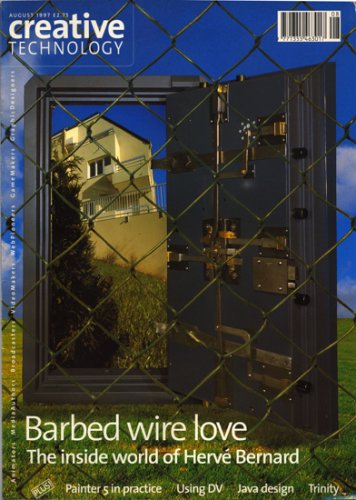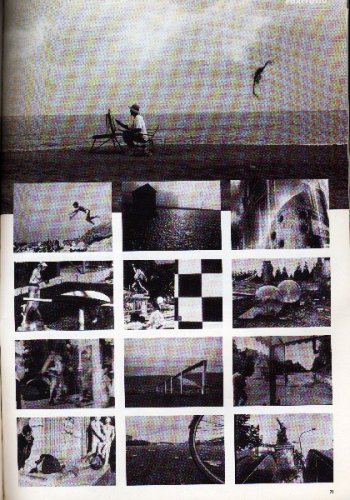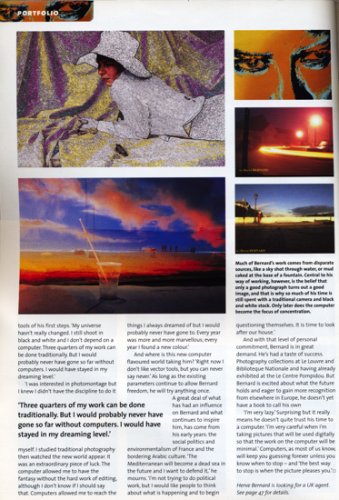Barbed with love, the inside of Hervé Bernard, August 1997
Work in progress
Elusive and dynamic, annoyed with question on routine, Hervé Bernard talks to Catherine Basset and Morgan Holt on the nature of the digital work.
I’m not married to a tool. There are so many, that you must simply choose the one you need.’
As a photographer, journalist, technical consultant, workshop leader, and part-time beta tester, Hervé Bernard has little patience for rank and routine, ’If 1 knew what that meant,’ he shrugs, ’1 would become a civil servant. But 1 do want to do cinema. 1 am doing books. 1 would like to do illustrated fairy tales. 1 wrote a short story fifteen years a go that 1 have recently begun to see in images. Perhaps it will become a short film.’
That script now exists in a pile of things to do. Projects are not in short supply for Bernard : ’To create is to decide. The difficulty for many people creating is that they cannot settle upon one image. That way,you can easily end up doing a lot of work without having any coherence. The problem is not having ideas, it is acting on them. The photographer, Robert Doisneau said « to create you have to be able to lose time »
Bernard cornes from that stable of philosophers that considers the process of work as a unified whole. If you try and take any one part of his work, he will bark at you for not considering another. Ask about names and he brushes the labels off. ’If my pictures don’t speak to you th en they don’t work.’
This humanistic approach came from an early introduction to the skill that has kept him going. At the aged of 14 he began ta king photographs and quietly said to himself : ’that’s what l’m going to do’. Not just photography, but that, like you go to a cinema and say ’1 want to do that.’ After an abortive attempt at mainstream university study in economies, he fou nd himself as an assistant in a photographie studio. A stint studying ’m ise en page’ (layout) in Belgium was followed by employment in the labs, then his first technological departure working on interfaces for France’s (long-before-its-time) network computer, Minitel. ’After 2 years of working with eight colour images 1 was fed up,’ but in spired enough to work with computer images and put photography back into his schedule of working life. ’1 learned the discipline of single images with black and white photography, but computers pushed theideas of merging multiple layers.’ Formerly a worshipper of ali things Sun, he now aIso resides in the comfortingly large world of Windows NT ’There’s more software for NT and it’s cheaper’ explains Bernard. The breadth of his technology runs from Quantel Paint Box and Silicon Graphies through Mac and PC, Scitex through to Photoshop. ’1 am platform and software independent.’
But to Bernard, black and white photography is as important as the digital art. ’They complement each other’ he explains. The computer’s ability to layer one image on another and lose the primary object of focus pushed him further into trying new thi ngs with photography. Yet his attention has remained primarily on the traditional tools of his first steps. ’My universe hasn’t really changed. 1 still shoot in black and white and 1 don’t depend on a computer. Three quarters of my work can be done traditionally. But 1 wouId probably never have gone so far without computers. 1 would have stayed in my dreaming level.’
’1 was interested in photomontage but 1 knew 1 didn’t have the discipline to do it myself 1 studied traditional photography then watched the new world appear. lt was an extraordinary piece of luck. The computer allowed me to have the fantasy without the hard work of editing, although 1 don’t know if 1 should say that. Computers allowed me to reach the things 1 always dreamed of but 1 wouId probably never have gone to. Every year was more and more marvellous ; every year 1 found a new colour.’
And where is this new computer flavoured world taking him ? ’Right now 1 don’t like vector tools, but you can never say never.’ As long as the existing parameters continue to allow Bernard freedom, he will try anything once.
A great dea1 of what has had an influence on Bernard and what continues to inspire him, has come from his early years : the social politics and environmentalism of France and the bordering Arabic culture. ’The Mediterranean will become a dead sea in the future and 1 want to defend it,’ he mourns. I’m not trying to do political work, but 1 wouId like people to think about what is happening and to begin questioning themselves. lt is time to look after our house.’
And with that level of personal commitment, Bernard is in great demand. He’s had a taste of success. Photography collections at Le Louvre and Biblioteque Nationale and having already exhibited at the Le Centre Pompidou. But Bernard is excited about what the future holds and eager to gain more recognition from elsewhere in Europe, he doesn’t yet have a book to call his own.
’l’rn very lazy.’ Surprising but it really means he doesn’t quite trust his time to a computer. Tm very careful when l’rn taking pictures that will be used digitally so th at the work on the computer will be minimal.’ Computers, as most of us know, will keep you guessing forever unless you know when to stop - and ’the best way to stop is when the picture pleases you.’
Encadré
Much of Bernard’s work comes from disparate sources,like a sky shot through water, or mud caked at the base of a fountain. Central to his way of working, however, is the belief that only a good photograph turns out a good image, and that is why so much of his ti me is still spent with a traditional camera and black and white stock. Only later does the computer become the focus of concentration.
 Regard sur l’image
Regard sur l’image



